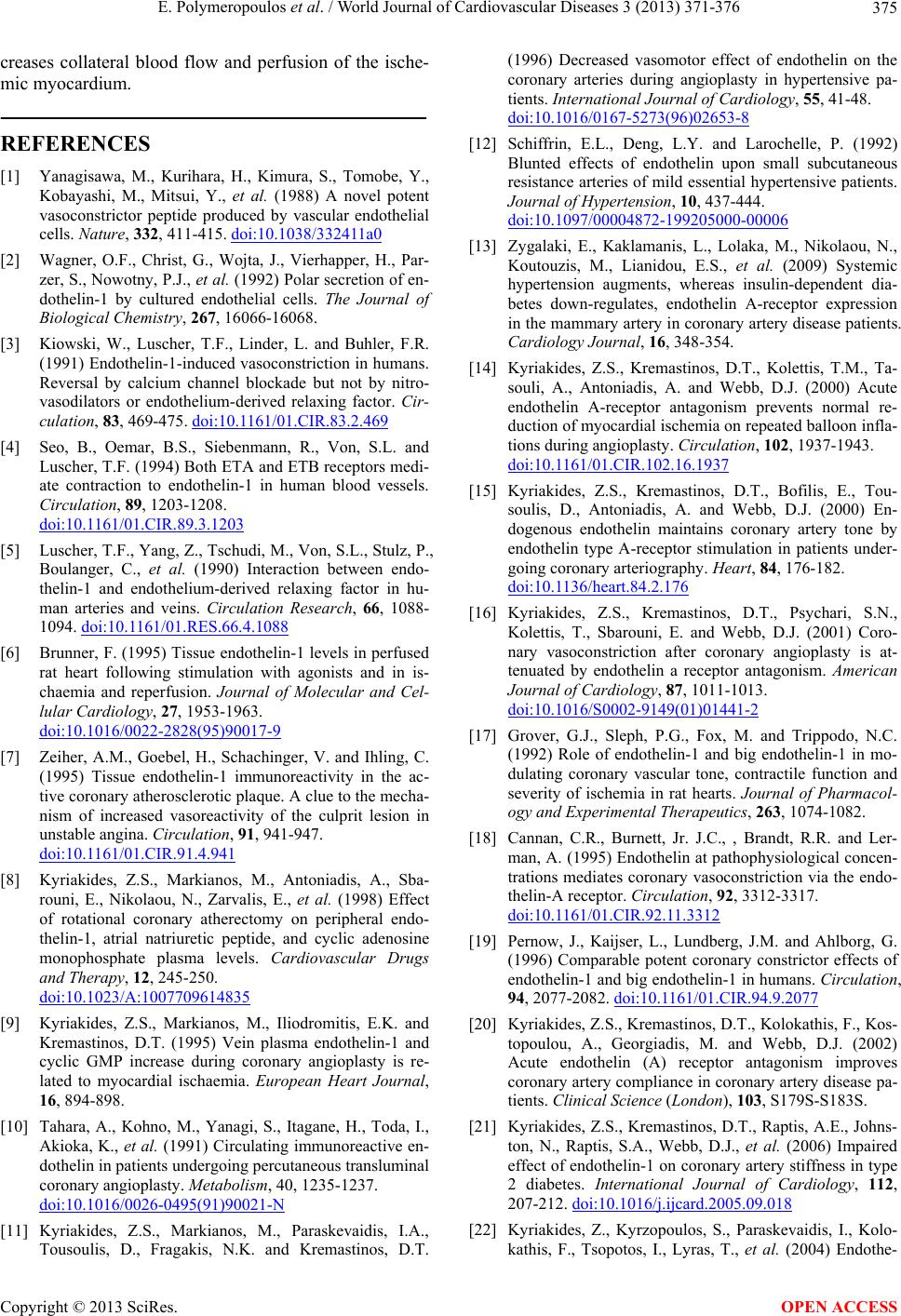
E. Polymeropoulos et al. / World Journal of Cardiovascular Diseases 3 (2013) 371-376 375
creases collateral blood flow and perfusion of the ische-
mic myocardium.
REFERENCES
[1] Yanagisawa, M., Kurihara, H., Kimura, S., Tomobe, Y.,
Kobayashi, M., Mitsui, Y., et al. (1988) A novel potent
vasoconstrictor peptide produced by vascular endothelial
cells. Nature, 332, 411-415. doi:10.1038/332411a0
[2] Wagner, O.F., Christ, G., Wojta, J., Vierhapper, H., Par-
zer, S., Nowotny, P.J., et al. (1992) Polar secretion of en-
dothelin-1 by cultured endothelial cells. The Journal of
Biological Chemistry, 267, 16066-16068.
[3] Kiowski, W., Luscher, T.F., Linder, L. and Buhler, F.R.
(1991) Endothelin-1-induced vasoconstriction in humans.
Reversal by calcium channel blockade but not by nitro-
vasodilators or endothelium-derived relaxing factor. Cir-
culation, 83, 469-475. doi:10.1161/01.CIR.83.2.469
[4] Seo, B., Oemar, B.S., Siebenmann, R., Von, S.L. and
Luscher, T.F. (1994) Both ETA and ETB receptors medi-
ate contraction to endothelin-1 in human blood vessels.
Circulation, 89, 1203-1208 .
doi:10.1161/01.CIR.89.3.1203
[5] Luscher, T.F., Yang, Z., Tschudi, M., Von, S.L., Stulz, P.,
Boulanger, C., et al. (1990) Interaction between endo-
thelin-1 and endothelium-derived relaxing factor in hu-
man arteries and veins. Circulation Research, 66, 1088-
1094. doi:10.1161/01.RES.66.4.1088
[6] Brunner, F. (1995) Tissue endothelin-1 levels in perfused
rat heart following stimulation with agonists and in is-
chaemia and reperfusion. Journal of Molecular and Cel-
lular Cardiology, 27, 1953-1963.
doi:10.1016/0022-2828(95)90017-9
[7] Zeiher, A.M., Goebel, H., Schachinger, V. and Ihling, C.
(1995) Tissue endothelin-1 immunoreactivity in the ac-
tive coronary atherosclerotic plaque. A clue to the mecha-
nism of increased vasoreactivity of the culprit lesion in
unstable angina. Circulation, 91, 941-947.
doi:10.1161/01.CIR.91.4.941
[8] Kyriakides, Z.S., Markianos, M., Antoniadis, A., Sba-
rouni, E., Nikolaou, N., Zarvalis, E., et al. (1998) Effect
of rotational coronary atherectomy on peripheral endo-
thelin-1, atrial natriuretic peptide, and cyclic adenosine
monophosphate plasma levels. Cardiovascular Drugs
and Therapy, 12, 245-250.
doi:10.1023/A:1007709614835
[9] Kyriakides, Z.S., Markianos, M., Iliodromitis, E.K. and
Kremastinos, D.T. (1995) Vein plasma endothelin-1 and
cyclic GMP increase during coronary angioplasty is re-
lated to myocardial ischaemia. European Heart Journal,
16, 894-898.
[10] Tahara, A., Kohno, M., Yanagi, S., Itagane, H., Toda, I.,
Akioka, K., et al. (1991) Circulating immunoreactive en-
dothelin in patients undergoing percutaneous transluminal
coronary angioplasty. Metabolism, 40, 1235-1237.
doi:10.1016/0026-0495(91)90021-N
[11] Kyriakides, Z.S., Markianos, M., Paraskevaidis, I.A.,
Tousoulis, D., Fragakis, N.K. and Kremastinos, D.T.
(1996) Decreased vasomotor effect of endothelin on the
coronary arteries during angioplasty in hypertensive pa-
tients. International Journal of Cardiology, 55, 41-48.
doi:10.1016/0167-5273(96)02653-8
[12] Schiffrin, E.L., Deng, L.Y. and Larochelle, P. (1992)
Blunted effects of endothelin upon small subcutaneous
resistance arteries of mild essential hypertensive patients.
Journal of Hypertension, 10, 437-444.
doi:10.1097/00004872-199205000-00006
[13] Zygalaki, E., Kaklamanis, L., Lolaka, M., Nikolaou, N.,
Koutouzis, M., Lianidou, E.S., et al. (2009) Systemic
hypertension augments, whereas insulin-dependent dia-
betes down-regulates, endothelin A-receptor expression
in the mammary artery in coronary artery disease patients.
Cardiology Journal, 16, 348-354.
[14] Kyriakides, Z.S., Kremastinos, D.T., Kolettis, T.M., Ta-
souli, A., Antoniadis, A. and Webb, D.J. (2000) Acute
endothelin A-receptor antagonism prevents normal re-
duction of myocardial ischemia on repeated balloon infla-
tions during angioplasty. Circulation, 102, 1937-1943.
doi:10.1161/01.CIR.102.16.1937
[15] Kyriakides, Z.S., Kremastinos, D.T., Bofilis, E., Tou-
soulis, D., Antoniadis, A. and Webb, D.J. (2000) En-
dogenous endothelin maintains coronary artery tone by
endothelin type A-receptor stimulation in patients under-
going coronary arteriography. Heart, 84, 176-182.
doi:10.1136/heart.84.2.176
[16] Kyriakides, Z.S., Kremastinos, D.T., Psychari, S.N.,
Kolettis, T., Sbarouni, E. and Webb, D.J. (2001) Coro-
nary vasoconstriction after coronary angioplasty is at-
tenuated by endothelin a receptor antagonism. American
Journal of Cardiology, 87, 1011-1013.
doi:10.1016/S0002-9149(01)01441-2
[17] Grover, G.J., Sleph, P.G., Fox, M. and Trippodo, N.C.
(1992) Role of endothelin-1 and big endothelin-1 in mo-
dulating coronary vascular tone, contractile function and
severity of ischemia in rat hearts. Journal of Pharmacol-
ogy and Experimental Therapeutics, 263, 1074-1082.
[18] Cannan, C.R., Burnett, Jr. J.C., , Brandt, R.R. and Ler-
man, A. (1995) Endothelin at pathophysiological concen-
trations mediates coronary vasoconstriction via the endo-
thelin-A receptor. Circulation, 92, 3312-3317.
doi:10.1161/01.CIR.92.11.3312
[19] Pernow, J., Kaijser, L., Lundberg, J.M. and Ahlborg, G.
(1996) Comparable potent coronary constrictor effects of
endothelin-1 and big endothelin-1 in humans. Circulation,
94, 2077-2082. doi:10.1161/01.CIR.94.9.2077
[20] Kyriakides, Z.S., Kremastinos, D.T., Kolokathis, F., Kos-
topoulou, A., Georgiadis, M. and Webb, D.J. (2002)
Acute endothelin (A) receptor antagonism improves
coronary artery compliance in coronary artery disease pa-
tients. Clinical Science (London), 103, S179S-S183S.
[21] Kyriakides, Z.S., Kremastinos, D.T., Raptis, A.E., Johns-
ton, N., Raptis, S.A., Webb, D.J., et al. (2006) Impaired
effect of endothelin-1 on coronary artery stiffness in type
2 diabetes. International Journal of Cardiology, 112,
207-212. doi:10.1016/j.ijcard.2005.09.018
[22] Kyriakides, Z., Kyrzopoulos, S., Paraskevaidis, I., Kolo-
kathis, F., Tsopotos, I., Lyras, T., et al. (2004) Endothe-
Copyright © 2013 SciRes. OPEN ACCESS